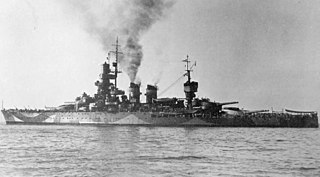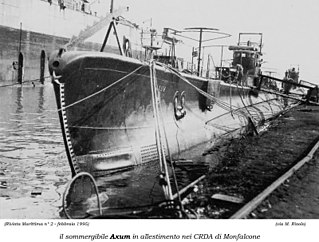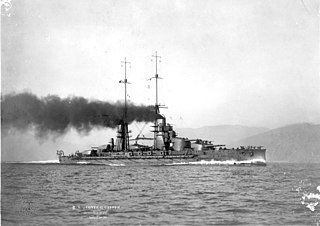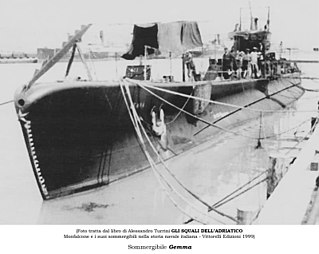 W
WThe Acciaio-class submarine was the fifth subclass of the 600 Series of coastal submarines built by the Regia Marina. They were completed during the early 1940s and saw service in World War II.
 W
WItalian submarine Adua was an Adua-class submarine built in the 1930s, serving in the Regia Marina during World War II. She was named after Adwa, a town in northern Ethiopia.
 W
WItalian submarine Alagi was an Adua-class submarine built in 1930s serving in the Regia Marina during World War II. She was named after the Amba Alagi mountain in Ethiopia.
 W
WAndrea Doria was the lead ship of her class of battleships built by the Regia Marina. The class included only one sister ship, Caio Duilio. Andrea Doria was named after the 16th-century Genoese admiral of the same name. Laid down in March 1912, the battleship was launched a year later in March 1913, and completed in March 1916. She was armed with a main battery of thirteen 305 mm (12.0 in) guns and had a top speed of 21 knots.
 W
WItalian submarine Aradam was an Adua-class submarine built in the 1930s, serving in the Regia Marina during World War II. She was named after the Amba Aradam mountain in Ethiopia.
 W
WMS Augustus was a 27,090 GRT, luxury ocean liner built in 1950 for Italian Line. She was the sister ship to MS Giulio Cesare that was launched in the same year. These two ships were built to the same design, with similar specifications. After the Augustus was sold to Hong Kong, she sailed under five names. The ship was later sold to Manila Hotel and renamed MS Philippines, functioning as a static hotel. As reported by both Maritimematters, and maritime, the MS Philippines was sold for scrap in September 2011. As of December 2011, she was beached in Alang for scrapping.
 W
WSS Ausonia, later known as the SS Ivory and Aegean Two while in service with her last owners, Golden Star Cruises, was a cruise liner belonging to Louis Cruise Lines operating in the Mediterranean. She operated mostly cruise service during her 52 years of life. She was the last vintage Italian ocean liner in service when she was retired from service in September 2008 and beached for dismantling in March 2010.
 W
WItalian submarine Axum was an Adua-class submarine built in the 1930s, serving in the Regia Marina during World War II. She was named after an ancient city of Axum in Ethiopia.
 W
WBarbarigo was a World War II Italian Marcello-class submarine. It was built by the Cantieri Riuniti dell'Adriatico, and was commissioned on 19 September 1938.
 W
WBatory was an ocean liner of the Polish Merchant Navy, named after Stefan Batory, the sixteenth-century king of Poland. She was the sister ship of MS Piłsudski. After Allied wartime service, mainly under the UK Admiralty, she became in 1951 the flagship of the Polish Ocean Lines and the Polish merchant fleet.
 W
WItalian submarine Berillo was a Perla-class submarine built for the Royal Italian Navy during the 1930s. It was named after a gemstone Beryl.
 W
WConte di Cavour was the name ship of the three Conte di Cavour-class dreadnought battleships built for the Royal Italian Navy in the 1910s. Completed in 1915 she served during World War I, although she was little used and saw no combat. The ship supported operations during the Corfu Incident in 1923 and spent much of the rest of the decade in reserve. She was rebuilt between 1933 and 1937 with more powerful guns, additional armor and considerably more speed than before.
 W
WSS Conte di Savoia was an Italian ocean liner built in 1932 at the Cantieri Riuniti dell'Adriatico, Trieste.
 W
WItalian submarine Corallo was a Perla-class submarine built for the Royal Italian Navy during the 1930s. She was named after a gemstone Coral.
 W
WDelfino was one of four Squalo-class submarines built for the Regia Marina during the late 1920s. The boat served in World War II and was sunk in 1943 after a collision with another Italian ship.
 W
WItalian submarine Diaspro was a Perla-class submarine built for the Royal Italian Navy during the 1930s. She was named after a gemstone Jasper.
 W
WDona Nati was one of three identical cargo ships built in 1939 by Cantieri Riuniti dell'Adriatico, San Marco, Trieste, Italy, for the De la Rama S.S. Co. Inc., Iloilo, Philippines, intended for service between the Philippines West Coast and North America. The ship was engaged in normal commerce until it became a key player in events in the Philippines after December 7, 1941, and the Japanese invasion of the islands. Dona Nati had arrived in Manila along with the ships President Grant, John Lykes, Cape Fairweather, and American Leader in a convoy escorted by the USS Boise (CL-47) on December 4, 1941. She had escaped to Australia where she became particularly notable as being one of only three ships to successfully run the Japanese blockade in attempts to supply the forces cut off in the Philippines. The ship was retained under Army control and on April 28, 1943, was one of twenty-eight vessels forming the fleet available to the Southwest Pacific command under General MacArthur.
 W
WThe SS Eugenio C was a 1966 Italian built ocean liner/cruise ship originally owned by the Costa Line. She was scrapped as the Big Red at Alang, India in June 2005.
 W
WFiume was a Zara-class heavy cruiser of the Italian Regia Marina, named after the Italian city of Fiume, she was the second of four ships in the class, and was built between April 1929 and November 1931. Armed with a main battery of eight 8-inch (200 mm) guns, she was nominally within the 10,000-long-ton (10,000 t) limit imposed by the Washington Naval Treaty, though in reality she significantly exceeded this figure.
 W
WThe Flutto class were a large class of submarines built for the Italian Royal Navy during the Second World War.
 W
WSS Galileo Galilei was an ocean liner built in 1963 by Cantieri Riuniti dell' Adriatico, Monfalcone, Italy for Lloyd Triestino's Italy—Australia service. In 1979, she was converted to a cruise ship, and subsequently sailed under the names Galileo and Meridian. She sank in the Strait of Malacca in 1999 as the Sun Vista.
 W
WItalian submarine Gemma was a Perla-class submarine built for the Royal Italian Navy during the 1930s. Her name in Italian means a gemstone or jewel.
 W
WMS Giulio Cesare was a luxurious ocean liner built for the Italian Line. She was a sister ship to MS Augustus which was launched in the same year. She was built for the South America service like her sister. These two ships' specification and design were very similar.
 W
WGiuseppe Garibaldi was an Italian Duca degli Abruzzi-class light cruiser, that served in the Regia Marina during World War II. After the war she was retained by the Marina Militare and upgraded. She was built by CRDA, in Stabilimento Tecnico Triestino shipyard Trieste and named after the Italian general Giuseppe Garibaldi.
 W
WSS Guglielmo Marconi was an Italian ocean liner launched on 24 September 1961 for Lloyd Triestino's Genoa—Sydney service. Her sister ship was SS Galileo Galilei. Guglielmo Marconi left Genoa on her maiden voyage on November 18th 1963. In 1976, Guglielmo Marconi was transferred to the Naples-Brazil-River Plate service of Italia Line.
 W
WLeonardo da Vinci was a Marconi-class submarine of the Italian navy during World War II. It operated in the Atlantic from September 1940 until its loss in May 1943, and became the top scoring non-German submarine of the entire war.
 W
WLuigi Cadorna was an Italian Condottieri-class light cruiser, which served in the Regia Marina during World War II; named after Italian Field Marshal Luigi Cadorna who was commander in Chief of the Italian Army during World War I.
 W
WMuzio Attendolo was a Condottieri-class light cruiser of the Italian Regia Marina which fought in World War II. She was sunk in Naples by bombers of the United States Army Air Forces (USAAF) on 4 December 1942. Although salvaged after the war, she was damaged beyond repair and was scrapped.
 W
WNarvalo was one of four Squalo-class submarines built for the Regia Marina during the late 1920s. The boat served in World War II and was sunk in 1943 by British destroyers and aircraft.
 W
WSS Oceanic was a cruise ship owned and operated by Peace Boat. She was built in 1963 by Cantieri Riuniti dell' Adriatico, Monfalcone, Italy for Home Lines. Between 1985 and 2000, she sailed for Premier Cruise Line under the names Starship Oceanic and Big Red Boat I, before being sold to Pullmantur Cruises and reverting to her original name. In 2009 she left the Pullmantur fleet for Peace Boat.
 W
WItalian submarine Perla was a Perla-class submarine built for the Royal Italian Navy during the 1930s. She was named after a gemstone Pearl.
 W
WThe Perla-class submarines were the third sub-class of the 600 Series of coastal submarines built for the Royal Italian Navy during the 1930s and named after gemstones. Of the ten boats built of this class, only three survived World War II.
 W
WMS Piłsudski was a medium-size ocean liner of the Polish Merchant Marine, named for Marshal Józef Piłsudski, a national hero of Poland. She was built in Italy by the CRDA yard at Monfalcone, yard number 1126, for Polskiego Transatlantyckiego Towarzystwa Okrętowego, which in 1934 became Gdynia – Ameryka Linie Zeglugowe, with part of the payment being shipments of coal from Poland. Launched in December 1934, her tonnage was 14,294 tons gross, with a length of 162 metres (531 ft) and beam of 22 metres (71 ft). She was propelled by two diesel engines driving a pair of propellers giving a speed of 18 knots (33 km/h).
 W
WSS Raffaello was an Italian ocean liner built in the early 1960s for Italian Line by the Cantieri Riuniti dell'Adriatico, Trieste. It was one of the last ships to be built primarily for liner service across the North Atlantic. Her sister ship was SS Michelangelo.
 W
WThe Italian auxiliary cruiser Ramb II was a pre-war banana boat built at Monfalcone by the CRDA in 1937. She briefly served as an auxiliary cruiser with Regia Marina early in World War II before becoming an auxiliary transport with the Imperial Japanese Navy later in her career.
 W
WRamb IV was an Italian hospital ship, built at Monfalcone by the United Yards of the Adriatic in 1938.
 W
WRoma, named after two previous ships and the city of Rome, was the third Littorio-class battleship of Italy's Regia Marina. The construction of both Roma and her sister ship Impero was due to rising tensions around the world and the navy's fear that only two Littorios, even in company with older pre-First World War battleships, would not be enough to counter the British and French Mediterranean Fleets. As Roma was laid down almost four years after the first two ships of the class, some small improvements were made to the design, including additional freeboard added to the bow.
 W
WSqualo was the lead ship of her class of four submarines built for the Regia Marina during the late 1920s. The boat served in World War II and was decommissioned in 1948.
 W
WThe Squalo-class submarines were a group of four submarines built for the Royal Italian Navy during the 1930s. They were built at the Cantieri Riuniti dell'Adriatico (CRDA) shipyard at Monfalcone, and designed by Curio Bernardis.
 W
WMS Stockholm was the name of two near-identical ocean liners built by Cantieri Riuniti dell' Adriatico, Monfalcone, Italy between 1936 and 1941 for the Swedish American Line. Neither of the ships entered service for the company that had ordered them—the first ship was entirely destroyed by fire during construction in 1938, while the second was completed in 1941 but immediately sold to the Italian government as a troopship. The second ship served for three years in the Regia Marina and Kriegsmarine under the name MS Saubadia, until sunk by British bombers outside Trieste in 1944. It is unknown if she was ever actually used as a troopship.
 W
WTricheco was one of four Squalo-class submarines built for the Regia Marina during the late 1920s. The boat served in World War II and was sunk in 1942 by the British submarine HMS Upholder.
 W
WVittorio Veneto was the second member of the Littorio-class battleship that served in the Italian Regia Marina during World War II. The ship's keel was laid down in October 1934, launched in July 1937, and readied for service with the Italian fleet by August 1940. She was named after the Italian victory at Vittorio Veneto during World War I, and she had three sister ships: Littorio, Roma, and Impero, though only Littorio and Roma were completed during the war. She was armed with a main battery of nine 381-millimeter (15.0 in) guns in three triple turrets, and could steam at a speed of 30 knots.